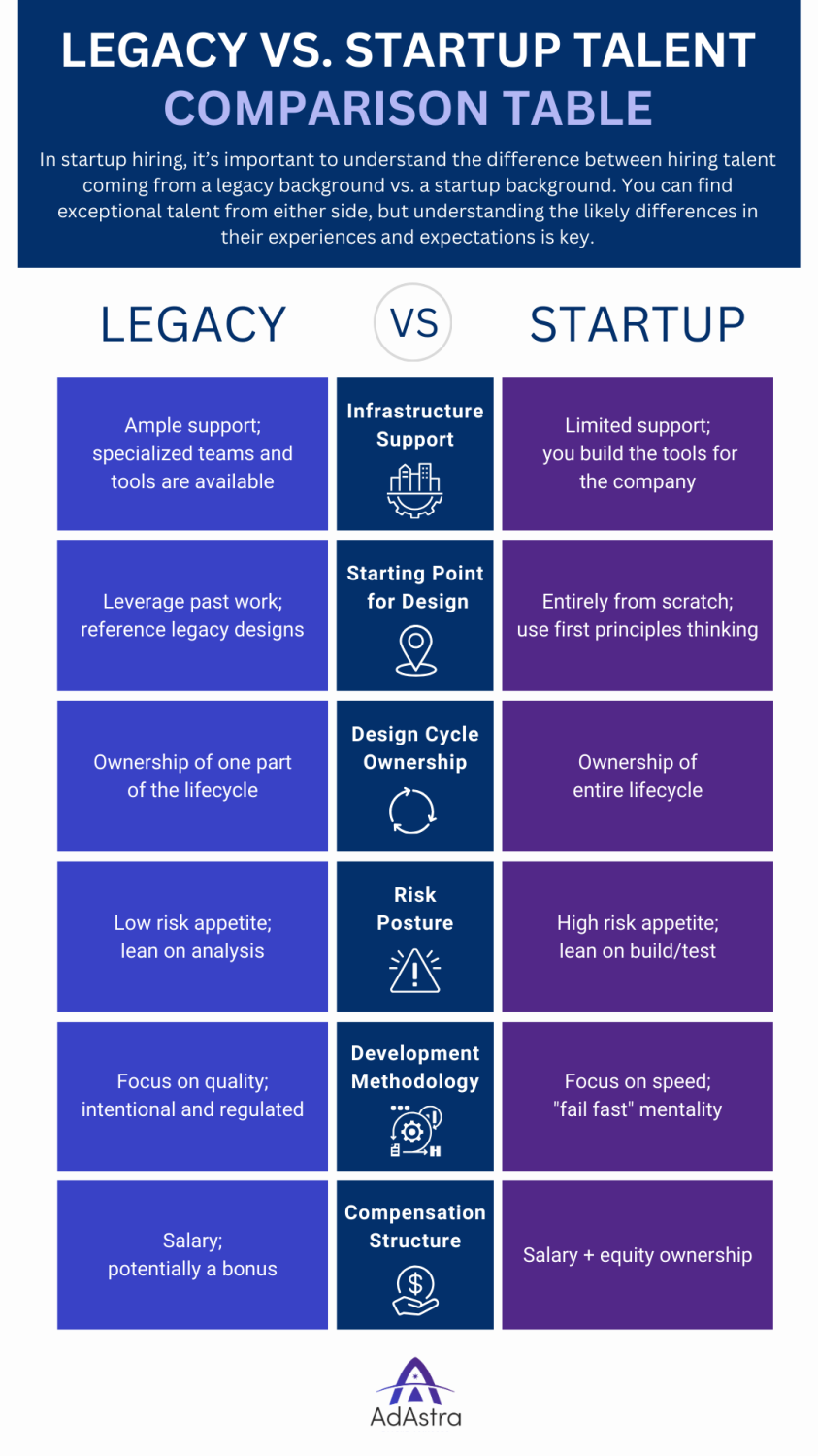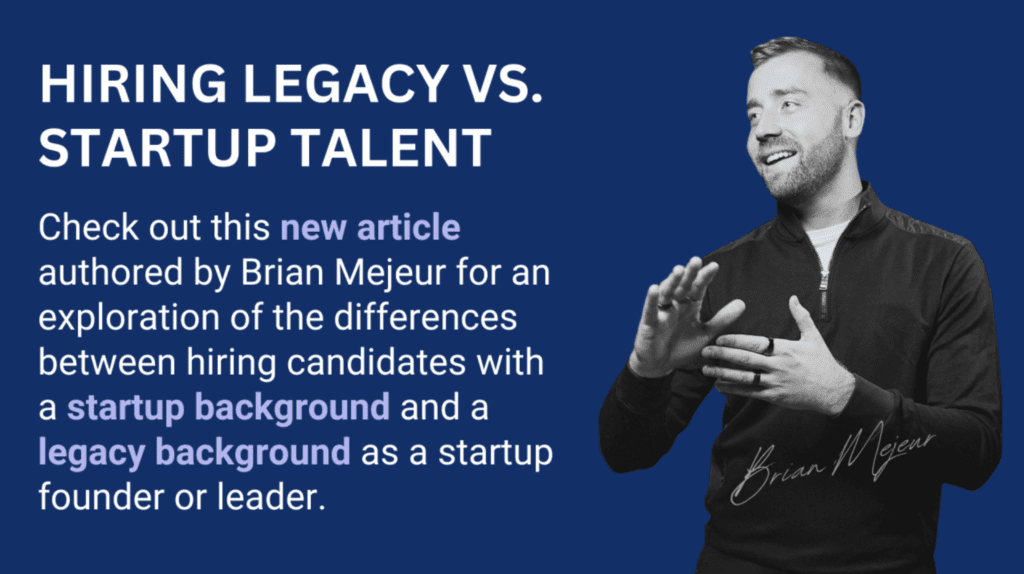
Brian Mejeur
Co-Founder and COO/CTO of AdAstra Talent Advisors
When you’re done with this article, head over to my LinkedIn and connect with me to keep getting more insightful content about the talent landscape of the NewSpace and Clean Tech industries.
“When hiring for my startup, do I have to hire from other startups or can I also hire from legacy orgs? What considerations are important for candidates coming from each background?”
I get questions like this all of the time from startup founders and hiring managers!
As a co-owner of AdAstra Talent Advisors, a boutique headhunting firm that partners with NewSpace and Clean Tech startup companies to find and secure highly technical and executive talent, I have a lot of experience on this topic. The short answer is that you can find exceptional talent from either background, but understanding likely differences in experiences and expectations will set both you and the candidate up for success.
Most of you will already have a sound understanding of what I mean by legacy and startup organizations, but for the sake of clarity, let’s go through some quick definitions.
When I refer to legacy organizations, I’m talking about larger, structured companies that have been around for a while. Legacy organizations in aerospace include companies like Boeing, Raytheon, Lockheed Martin, Northrop Grumman, and other successful giants. Many of them are publicly traded and they rely on predictable recurring revenue.
Startups, on the other hand, are newer companies that are in early stages of operation and function a lot differently than their legacy counterparts. Pre-IPO startups rely on investments from venture capital firms, individual investors, or government grants as the path to profitability typically takes many years.
So, why does it matter which environment a candidate is coming from? Startup candidates and legacy candidates are very likely accustomed to different things when it comes to their work style, responsibilities, company structure, and organizational priorities. There are six categories where I see foundational differences between the two: Infrastructure Support, Starting Point for Design, Design Cycle Ownership, Risk Posture, Development Methodology, and Employee Compensation Structure.
Are there exceptions to statements made below? Absolutely. This is a valuable framework to help startup leaders wrap their heads around common candidate differences, but like any framework, there will be additional nuances to consider with each individual candidate.
When hiring for your company, leverage this information while keeping an open mind!

1. Infrastructure Support
Naturally, in a larger and more developed company setting, there will be ample infrastructure support available. This includes specialized teams and tools for things like IT, recruiting, client / customer service, and beyond.
In a startup environment, it’s much more common for employees to build tools and processes for a company as it develops. If there’s an infrastructure support gap, or an undefined path forward, engineers need to take it upon themselves to create solutions.
- Note to hiring managers: If a legacy candidate is used to having this level of support services available, it’s important to understand whether they’re comfortable with less defined infrastructure and able to really embrace a “figure it out” mentality. For startup candidates, consider asking about ways they’ve taken initiative to build and improve company tools and processes.
2. Starting Point for Design
In a legacy company setting, it’s common for engineers to take an existing design and build off of it, referencing tried and true models.
At startups, on the other hand, engineers are typically building something entirely from scratch without referencing a legacy design since legacy designs don’t exist, and the tech they’re building probably doesn’t exist yet either!
- Note to hiring managers: The fundamental thing we want to understand here is whether or not a candidate can confidently guide early decisions like requirements definition, which are often completely undefined in a startup.
3. Design Cycle Ownership
Legacy candidates typically own one part of the design cycle, whether that’s defining early architecture, preliminary design, prototyping, testing, implementation, and so on. Larger companies use workforce specialization as a way to compartmentalize expertise at each step of the process.
Startup candidates, especially advanced talent, have likely owned not only parts, but whole systems, from cradle to grave by having full ownership of most, if not all, stages of development.
- Note to hiring managers: If your goal is to hire someone who can really own a cradle to grave design, asking about their contribution to different stages of the design cycle as well as support received during that time will help you understand their ability to successfully bring something from start to finish.
4. Risk Posture
When it comes to risk appetite, legacy companies have much less interest in risk taking as a general rule of thumb as it can cut into their bottom line. This means much more analysis is done early on in order to lower build, test, and manufacturing risk.
Startup companies have a much higher risk appetite in order to push the boundaries. In that environment, limiting risk means limiting potential.
- Note to hiring managers:Understanding a candidate’s sentiment towards risk, and ensuring their understanding of your company’s interpretation of risk vs. structure will help set the stage for an aligned relationship.
5. Development Methodology
Similar principles to risk posture apply to overall development methodology. It’s difficult to deliver an exceptionally high quality product quickly. Legacy companies traditionally prioritize quality, often at the expense of speed. Their processes are intentional and regulated in order to have a predictable path to success.
A startup company will have a much greater focus on speed and are willing to sacrifice having it right the first time. Typically that means that embracing a “fail fast” mentality. The best startup leaders strategically embrace risk taking, and encourage quick learning from mistakes.
- Note to hiring managers: Sometimes candidates that are coming from a regulated and methodical development environment can struggle with the development pace at a startup. In what timeframe do you need to see results, and how does that compare to their past project’s time to completion?
6. Employee Compensation Structure
At legacy companies, most compensation packages typically focus on a base salary with a bonus sometimes being offered.
Startup compensation packages often include salary in addition to ownership (equity) in the company. This can mean slightly lower cash offers with the potential to earn BIG if and when the startup succeeds. Of course, there are other aspects to total compensation like benefits, PTO, retirement saving support – but you’ll see solid coverage of these areas on both sides of the table.
- Note to hiring managers: If you’re speaking to a candidate that’s used to a base salary without equity, invest the time to help them understand the current value, and even more importantly, the potential future value, of the equity portion of the offer. It can help to frame it by explaining that the cash is there to make your life work but the equity is where you can experience upside not possible with legacy companies..
During the interview process, it’s important to discover the unique aspects of each candidate. Assumptions are dangerous in hiring. That said, having a foundational understanding of common differences in experiences between legacy and startup candidates will help you determine which unique questions to ask and important expectations to set throughout the hiring process.
AdAstra has placed really strong candidates at startups that come from both types of backgrounds. In my experience, it’s more common for candidates with startup experience to be able to hit the ground running in another startup, but as I’ve emphasized here, there are plenty of exceptions to this rule.
I’m so curious to hear other perspectives on the comparison made in this chart and article. What resonates? What doesn’t? What am I missing? Please share more about your thoughts in the comments!
If you’re happy with what you’ve read check out these other channels for great content:














